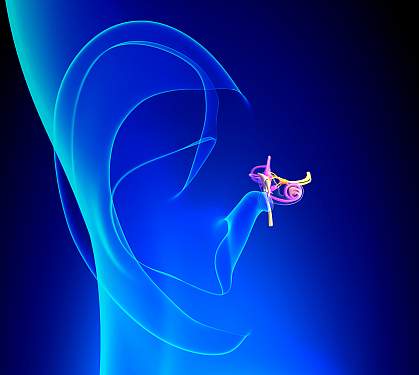You are here
September 27, 2016
Developing novel ear infection treatments
At a Glance
- Researchers engineered a gel to deliver antibiotics directly into the ear and successfully treated ear infections in chinchillas.
- The study demonstrates a potentially simpler ear infection treatment than traditional oral antibiotics.

Ear infections are the most common reason parents bring their children to the doctor’s office. An ear infection entails inflammation and buildup of fluid in the middle ear, located just behind the eardrum. Anyone can get an ear infection, but children get them more often than adults.
Ear infections are commonly caused by bacteria. They’re often treated with a 7–10 day course of oral antibiotics. But getting young children to take the medication can be difficult. Stopping the medicine too soon can allow the infection to come back and cause bacteria to become resistant to antibiotics.
A research team led by Dr. Daniel Kohane at Boston Children’s Hospital investigated an easier way to deliver ear infection medication. They engineered an antibiotic-containing gel that can be inserted directly inside the ear canal. They then tested if the gel could treat ear infections in chinchillas, the gold-standard animal model for studying ear infection. The research was funded in part by NIH’s National Institute on Deafness and Other Communication Disorders (NIDCD). Results were published in Science Translational Medicine on September 14, 2016.
The scientists evaluated different chemical formulations to create a polymer solution that could be injected into the ear canal as a liquid, harden into a gel upon contacting the warm ear drum, and slowly degrade over time. They tested 2 of the gel solutions as a potential drug-delivery system. The solutions had a copolymer called P407 or a modified copolymer called P407-PBP. Both contained the antibiotic ciprofloxacin and chemical permeation enhancers, which help the drug get across the eardrum into the middle ear.
Chinchillas with an ear infection caused by Haemophilus influenza received antibiotics through one of the gels or via liquid drops placed directly onto the eardrum. All 10 of the animals treated with the gel containing P407-PBP cleared the infection after 24 hours. Only 62% of animals that received liquid drops and 60% treated with P407 gel cleared the infection after 7 days. The P407-PBP gel continued releasing antibiotics into the middle ear throughout the week, whereas the other treatments stopped by day 3.
The chinchillas had no detectable antibiotics in their bloodstream, suggesting that the approach could help avoid side effects and antibiotic resistance caused by oral medications. Animals that were given the gel treatment showed a minor hearing deficit comparable to the effects of ear wax. However, the authors suggest this could resolve once the gel fully dissolved.
“With oral antibiotics, you have to treat the entire body repeatedly just to get to the middle ear,” says first author Dr. Rong Yang at Boston Children’s Hospital. “With the gel, a pediatrician could administer the entire antibiotic course all at once, and only where it’s needed.” More studies are needed to optimize the gel’s design and determine whether it would be safe and effective for people.
—by Tianna Hicklin, Ph.D.
Related Links
References: Treatment of otitis media by transtympanic delivery of antibiotics. Yang R, Sabharwal V, Okonkwo OS, Shlykova N, Tong R, Lin LY, Wang W, Guo S, Rosowski JJ, Pelton SI, Kohane DS. Sci Transl Med. 2016 Sep 14;8(356):356ra120. doi: 10.1126/scitranslmed.aaf4363. PMID: 27629487.
Funding: NIH’s National Institute of Deafness and Other Communication Disorders (NIDCD); Center for Integration of Medicine and Innovative Technology; Massachusetts General Hospital; Shereta Seelig Charitable Foundation Trust; Boston Children’s Hospital
